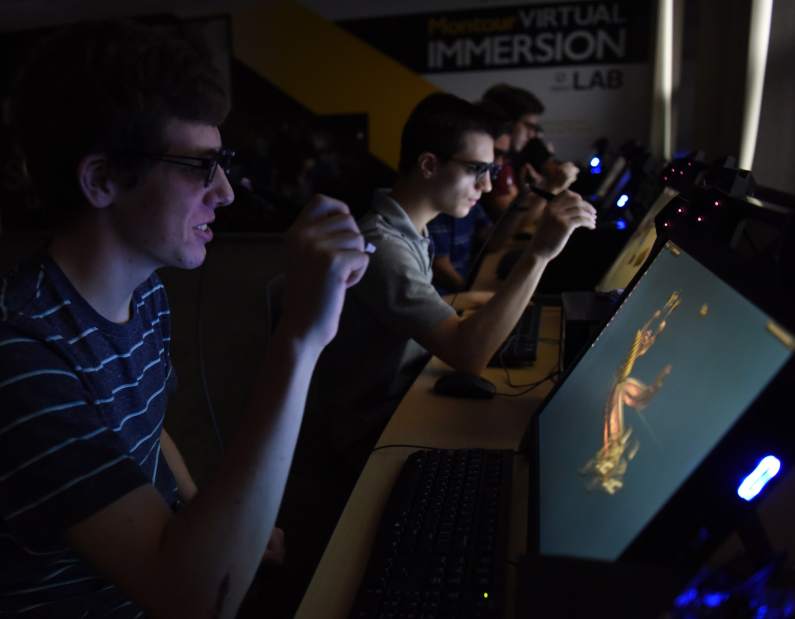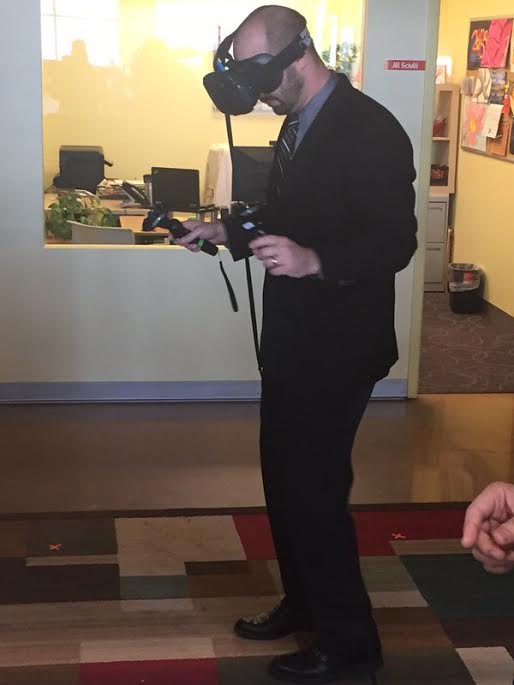In the fall of 2015, the Montour School District opened its doors to a new Virtual Immersion Lab. At first, students did not know what to expect (nor the teachers). However, on his first day using the lab, a physics student engage with virtual reality and expressed, “This is like hands-on learning, without wanting to let go.”
It was clear the risk was worth the reward.
Though new virtual reality and augmented tools come out and hit markets seemingly every month (like Pokemon GO—you knew I was going to bring it up somewhere), the educational value of VR and AR may still be unknown to many educators. However, there is no slowing down for new development of VR and AR technologies. And at Montour, there’s no slowing down, either.
Here’s a peek inside how we’re bringing AR and VR to our students—and how you can, too.
Inside the Virtual Immersion Lab and Montour’s Plans
The Virtual Immersion Lab at Montour is powered by the virtual reality edtech tool zSpace, which creates a 3D learning experience for kids. Through zSpace, students are able to dissect an eye-ball, T-Rex, 1968 Dodge Challenger, or almost anything they want—virtually. Students are also using the virtual reality tool for electrical engineering, physics, biomedical engineering, and mold clay models.

Montour has also indulged in augmented reality through Happy Atoms (see video below), a tangible, interactive learning tool that combines a digital app with a physical model set to teach students about molecular modeling. Students can build a molecule with the physical set, snap a picture with the augmented reality app, and discover what they have made. Combining these platforms will let students from 4th grade through college approach chemistry from a different angle.
Montour has also gone beyond its walls, partnering with Schell Games, a Pittsburgh-based game development company founded by former Disney Imagineer and Carnegie Mellon University's Entertainment Technology Center Distinguished Professor Jesse Schell.
In the fall of 2016, Montour chemistry students and teachers will work side-by-side to explore the viability of a virtual reality chemistry lab called SuperChem VR. Schell Games partnered with the RAND Corporation's Pittsburgh office to earn a small business innovation research grant from the Institute of Education Sciences at the US Department of Education, which will allow the team to begin developing the immersive virtual reality chemistry lab with formative feedback from teachers and students.
So You Want to Better Integrate VR and AR?
Since VR/AR is still being explored and researched worldwide, the future for many educators is still uncertain. For now, here are five quick tips if you want to try VR/AR in your class today:
Relate it to your current content. Like all new edtech tools, VR/AR should enhance learning and be embedded into current standards while simultaneously providing more authentic real-world learning experiences.
Use VR/AR to spark curiosity to generate open-ended discussions or activities in class. Educators often teach to spark “the light bulb” in their students, but let VR/AR be the spark to provide deeper learning.
If possible, connect the learning to action research—research conducted to solve an immediate problem. What are the benefits of using VR/AR? Have students collect data along the way to research VR and AR’s effectiveness.
Have students create VR/AR content—not just consume information. Let students create content, presentations, etc. Do not substitute VR/AR as another shiny textbook.
Finally, have fun and share your successes. We always learn best when we are excited and that excitement should be shared and enjoyed by others.
There are also plenty of resources to help you learn more about virtual reality/augmented reality, including:
- ImmersiveTechnology.com
- The Friday Institute for Education Innovation and the zSpace STEM Lab
- The Virtual Reality Society
- Building Virtual Worlds out of Carnegie Mellon

Where We Go From Here
Overall, all I can recommend is for educators to embrace VR/AR, and learn alongside their peers and students—because before we know it, more and more companies will be vying for our time and attention. Teachers and administrators in Texas, for example, recently experienced educator Ron Clark as a hologram at the annual Rigor, Relevance and Relationships conference held by Cypress-Fairbanks Independent School District in June. The Ron Clark hologram was made possible through a partnership between Promethean and ARHT Media, and according to Promethean CMO Vincent Young, it was the first time that this type of augmented holographic technology was used to deliver teacher and administrator training in an educational setting:
“Over time, Promethean’s vision is to work with ARHT Media to bring augmented reality technology to mass audiences in education. We envision the best experts and educators in the world beaming into schools on a monthly, weekly, or even daily basis.”
The more we use VR/AR in the classroom, the more we will learn how to use it effectively—and how to pick the best tools that work for our students. If our goal as educators is to have students become future-ready, let’s go to the future together.


